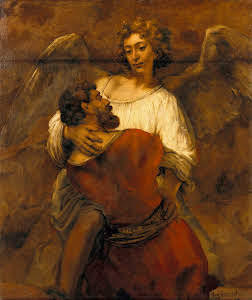|

The Color of Prayer: Poems on Rembrandt Painting the Bible
by James Green
16 poems, plus 16 color plates (Rembrandt) and introductory essay ~ 55 pages
Price: $13.95
Publisher: Shanti Arts Publishing
ISBN: 978-1-947067-79-0
To Order: https://www.shantiarts.co
or, from the author at jegreen159@gmail.com
Reviewed by Michael Escoubas
Like many authors, I hold membership in several “writers’ groups.” One such group bears the moniker Poetry Pilgrims. We believe reading and writing poems is a journey that will last a lifetime. It would be awful to reach a destination that implies, We have arrived. There is nothing more to learn or do.
Such thoughts returned to me during my pilgrimage with James Green’s new collection The Color of Prayer: Poems on Rembrandt Painting the Bible. In fact pilgrimage is a theme Green uses effectively throughout his interpretation of Rembrandt’s work.
Design Features
Green showcases sixteen iconic works by the Dutch Master. Examples include: Self-Portrait at the Age of Sixty-Three, The Stoning of St. Stephen, The Supper at Emmaus, and Jeremiah Lamenting the Destruction of Jerusalem, to name a few. He catalogues the paintings in order of appearance by title and year of composition. The one exception is a late painting featured early in the book. He also includes canvas sizes in both inches and centimeters, as well as the museums which currently host each work. The poet devotes five introductory pages to history and interesting facts about the scenes depicted. I was fascinated by notes on Rembrandt’s family history and religion. Paintings and poems are juxtaposed on facing pages. With few exceptions poems take up single pages. Paintings are placed at optical center which makes for a pleasant “eye” experience.
Stylistic Approach
The Greek term Ekphrastic means Description. The poet does describe each work. However, much more is involved. Writing primarily in free verse, James Green invests himself in the substance of Rembrandt’s work. The world of Rembrandt becomes the poet’s world. The Color of Prayer is the work of a credentialed scholar whose insights are as timeless as Rembrandt himself. Taken together, poet and artist shed light on the human condition.
Exhibit
As noted above, with rare exceptions the poems are written in free verse. However, an exception is Jacob Wrestling with the Angel. This project occupied Rembrandt during the years 1648-56. Green’s response is written in quatrains which scan a,b,b,a. Painting and poem, reproduced here in full, illustrate the poet’s strategy:

Although the text does not record that Jacob
wrestled with an angel, exactly,
you paint the scene with classic certainty:
the quintessential wings, a flowing robe,
complexion like a child’s, a yearning gaze.
You leave for us no doubt this is the face
of heaven’s grace whose hold is more embrace
and whose intention might have been to stay.
At sunrise Jacob claims his victory.
Still scuffling with the angel, he demands
a final blessing he misunderstands,
and unexpectedly receives one he
did not entreat, nor even comprehend.
And this is now the scene I want to see,
the man who hobbles off, the injury
Still throbbing with each step. What happens then,
When aching flesh revives the dream? Yes!
I’d like to see him after he first knows
he’s seen the face of God and that he goes
into the day confused as well as blessed.
By “strategy” I mean: Green talks to Rembrandt. I can almost feel the painter’s presence as the poet critiques his work. I was surprised to learn that Rembrandt himself was not particularly religious. However, he did struggle mightily with issues of faith. Green lays his finger on those struggles. Perhaps many readers share Rembrandt's conviction about life as revealed in the book’s inscription. The artist writes:
For the sake of my soul,
I don’t strive for glory but for freedom!
Green captures Rembrandt’s “hard-won peace.” In various paintings the artist “seeks to understand himself.” In another painting a new bride waits for her beloved to come to bed, “A wrinkled brow betrays anxiety.” Such gems are among many waiting to delight and challenge readers.
These collaborative works deserve a slow read. In an age of “hurry up,” how nice it is to hit the pause button and allow great poetry to merge with a master of brush and paint. That is precisely what James Green offers in The Color of Prayer.
|


